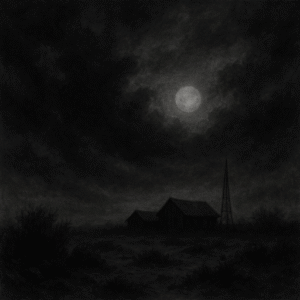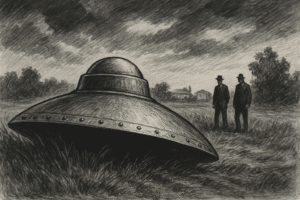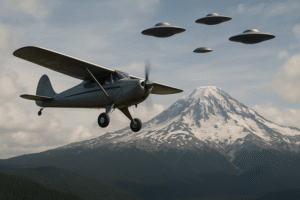In early July 1947, ranch foreman W.W. “Mac” Brazel, working the Foster ranch near Corona northwest of Roswell, found scattered debris after stormy weather. The discovery date is debated—some accounts say around June 14 while others place it the weekend of July 4–5—but by July 7–8 he had reported it to Sheriff George Wilcox, who in turn alerted Roswell Army Air Field (RAAF), home of the 509th Bomb Group. The base dispatched Major Jesse A. Marcel, the intelligence officer, and Captain Sheridan Cavitt of Counter-Intelligence to examine the site and collect samples. Within hours, base public information officer 1st Lt. Walter Haut issued a bulletin that went around the nation: the 509th had come into possession of a “flying disc.” The Roswell Daily Record front page for July 8, 1947 captured the moment with the headline “RAAF Captures Flying Saucer on Ranch in Roswell Region,” preserved here by Smithsonian’s Air & Space: Roswell Daily Record front page. A clear, mainstream recap of how the headline appeared and why it was walked back within hours is here: TIME: How Roswell became Roswell.
First on scene: who, where, and what they said
Brazel’s own interview the next day (July 9) described foil-like material, paper, tape with printed patterns, rubber, and small wooden beams over a broad patch of pasture—no engine or obvious metal structure, with the total weight only a few pounds. That language, quoted from the newspaper copy, is reproduced in the U.S. Air Force’s 1997 report appendices: USAF “Case Closed” (PDF). Marcel and Cavitt visited both the Proctor home (neighbors Floyd and Loretta Proctor) where some debris had been shown, and the ranch site itself, before returning material to RAAF for the intelligence shop. Colonel William H. Blanchard, the base commander, authorized Haut’s release, which said in plain language that rumors of “flying discs” had become reality in Roswell—an extraordinary claim coming from the only nuclear-armed unit on Earth at that time (Air & Space overview of the 1947 saucer wave).
The press release, the Fort Worth pivot, and the immediate media trail
On July 8, local radio men George Walsh (KSWS) and others pushed the story onto the wires. The same day, debris and officers were ordered to Fort Worth Army Air Field to brief Brig. Gen. Roger M. Ramey. In Ramey’s office, on-duty weather officer Irving Newton identified the laid-out material as parts of a standard radar target (“rawin”) and weather balloon. The Fort Worth photo session produced the famous images of Ramey and Maj. Marcel with foil, balsa frame, and rubber sheets on the floor. High-resolution scans of the session—including the so-called “Ramey memo” being held by the general—are hosted by UT Arlington Libraries: UT Arlington: Ramey memo & photo set. Meanwhile the FBI Dallas office sent a teletype noting that the Army had reported recovering a “flying disc” but that it resembled a high altitude weather balloon; the document is in the Bureau’s public vault: FBI Vault: Roswell teletype. By the morning of July 9, the Roswell Morning Dispatch led with the walk-back—army says “weather balloon”—a front page preserved here: CBS feature on the July 9 Dispatch headline. Wired’s concise timeline also captures the same-day whiplash: Wired anniversary note.
What the debris was said to be
The contemporary description—foil, paper, patterned tape, sticks, rubber, and extremely light—comes straight from Brazel’s July 9 interview as preserved in the USAF file. Later testimonies broadened the picture: Marcel, interviewed from 1978 onward by Stanton Friedman and others, spoke of a thin, shape-retaining foil and lightweight beams bearing unfamiliar symbols, insisting the Fort Worth display was not what he had brought from the ranch. TIME’s historical recap summarizes how those interviews reignited Roswell in the late 1970s and early 1980s: TIME: Roswell revival. For a readable collection of the Air Force’s own reproductions of press language—including Brazel’s weight estimate and material list—see the 1997 report: USAF “Case Closed” (PDF).
Military response and chain of custody
From Roswell to Fort Worth the chain ran through Ramey’s Eighth Air Force headquarters, with his chief of staff Col. Thomas J. DuBose later recalling that higher headquarters directed the handling and onward movement of material, and that the balloon angle served as a cover. DuBose’s later statements about the chain to Wright Field and instructions from Gen. Clements McMullen are summarized in the Defense Department’s compilation of GAO-related material: DoD/GAO packet (PDF). While the Fort Worth identification emphasized balloon/reflector parts, the speed of the re-routing, the photography session, and the day-after media management are exactly what you’d expect whether the military were protecting a sensitive domestic program or something stranger.
Was there a cover story—and if so, for what?
Two separate issues get blurred. First, was the weather balloon line a deliberate cover? The Air Force answered that in the 1990s: yes, a cover story was used. Second, was it covering up extraterrestrial hardware or a classified U.S. project? The 1994–95 report, triggered by Rep. Steven Schiff’s inquiry and a Government Accountability Office audit, concluded the debris most likely came from a long-train array associated with Project MOGUL—an NYU/Wright Field effort using strings of balloons, radar targets and acoustic gear to detect Soviet nuclear tests. The full report is here: USAF Roswell Report 1994/95 (PDF); the NSA hosts a copy referencing the A. P. Crary diary entries and flight notes: NSA-hosted copy (PDF). In 1997 the Air Force followed with Case Closed, arguing that later “bodies” stories grew from 1950s anthropomorphic test-dummy drops and unrelated accidents telescoped backward in memory: USAF “Case Closed” (PDF). The GAO’s audit that kicked all of this off—focused on records management and what files still existed—is here: GAO Report (PDF).
The countercase: witnesses who rejected the balloon explanation
On the pro-UFO side, the argument rests on named witnesses and a sequence of official actions. Marcel said repeatedly that the Fort Worth material was a swap for cameras and that the ranch debris had properties no balloon gear could match; DuBose called the balloon story a cover; flight engineer Robert Porter remembered lightweight boxed material and being told “flying saucer”; radio man Frank Joyce described Brazel changing tone after his base visit; and mortician Glenn Dennis told of calls about small body-handling and sealing materials. Public-facing summaries of the period, with quotes that map who said what and when, can be skimmed here: TIME overview. Walter Haut—who wrote the original press release—later signed a controversial 2002 affidavit, released after his death, claiming craft and bodies were seen and that Hangar 84 handled the recovery. A compact biography with references is here: Walter Haut (bio), and a skeptical breakdown of the affidavit’s conflicts is here: Skeptical Inquirer analysis (PDF). Proponents argue that the very features the Air Force cites for MOGUL—miles of line, balsa lattice, foil, odd tape—don’t fully account for the later shape-memory stories, the secrecy around shipment routing, or the intensity of the rapid media reversal.
The photos and the “Ramey memo”
The Fort Worth session is the visual heart of the case. The debris on the floor matches rawin radar targets and balloon remnants, and weather officer Irving Newton said exactly that at the time and again in 1990s interviews. The intrigue centers on the folded message in Ramey’s hand. Image-processing enthusiasts claim phrases like “victims of the wreck” can be teased out, while others show how noise and compression make decisive reading unreliable. If you want to judge for yourself, use the UT Arlington HDR scans: Ramey memo scans. A methods critique that cautions against over-interpreting the pixels is here: ResearchGate paper on memo decipherment. A widely shared image of the scene lives here: General Ramey with memo (Commons).
Context: the 1947 saucer wave
Roswell exploded during the first post-war UFO flap, kicked off by pilot Kenneth Arnold’s sighting over Mount Rainier on June 24, 1947—a story that gave the press the phrase “flying saucer” and primed the country to notice anything odd in the sky. Hundreds of reports followed within days. For scene-setting, see Air & Space’s capsule history of that summer: Air & Space: 1947, the year of the flying saucer, and a compact dossier on Arnold’s case: Kenneth Arnold sighting. That background matters: when Brazel walked into the sheriff’s office, the wires were already hot.
Aftershocks: how Roswell was revived
For decades the balloon explanation sat unchallenged in the mainstream. The story reignited in 1978 when physicist Stanton Friedman interviewed Marcel, and the 1980s/early 1990s brought a wave of books—Charles Berlitz and William Moore’s The Roswell Incident (1980), Kevin Randle and Donald Schmitt’s UFO Crash at Roswell (1991), Friedman and Don Berliner’s Crash at Corona (1992)—plus TV features that cemented Roswell in popular culture. That revival prompted the GAO review and the Air Force’s detailed responses in 1994–1997, which in turn sharpened the modern fault line: MOGUL cover versus craft recovery. A short, readable through-line is here: TIME: historical recap. For the government’s side, the primary PDFs remain the touchstones: USAF 1994/95, USAF 1997, and the GAO audit.
Assessment (leaning pro-UFO)
The first official word out of Roswell wasn’t rumor or anonymous gossip—it was a base press release from the nuclear 509th saying a “flying disc” had been captured. That’s the bedrock fact. The same-day pivot to weather balloon, confirmed by the Fort Worth photos and the FBI’s “resembled a high altitude weather balloon” teletype, fits a rapid containment plan. The Air Force’s 1990s admission of a cover story answers one question but not the big one. If you’re making the case that a craft came down, your strongest points are simple and documented: the base went public before it backtracked; senior officers later called the balloon line a cover; the chain of custody to Wright Field has been described by participants; and several witnesses described materials and scenes they believed were outside balloon tech. If you argue for MOGUL, you can show how a long-train array of balloons and rawin targets could produce exactly the odd assortment of lightweight debris Brazel listed, how weather and tracking explain the search area, and how the secrecy lay in the program rather than the hardware. The photographs and the memo won’t settle it by themselves. What does remain immovable is the sequence: disc first, balloon after. Seventy-plus years later, that order of events is why Roswell still bites.
Primary documents and high-value reads (live links)
Roswell Daily Record front page, July 8, 1947 — contemporary headline.
FBI Dallas teletype, July 8, 1947 — “resembled a high altitude weather balloon.”
UT Arlington: Ramey memo & Fort Worth photo scans — the floor debris and memo in hand.
Roswell Morning Dispatch, July 9, 1947 — day-after walk-back.
USAF Roswell Report (1994/95) — “Fact vs. Fiction in the New Mexico Desert” — MOGUL debris conclusion.
USAF “Case Closed” (1997) — dummy drops and later “bodies” stories.
GAO audit for Rep. Schiff (1995) — what records existed and where.
TIME: How Roswell became Roswell — concise historical through-line.
Wired: July 8 anniversary note — same-day press release and reversal.
Air & Space: 1947, the year of the flying saucer — national backdrop for the flap.
Kenneth Arnold sighting (dossier) — the case that primed the pump.
Deciphering the Ramey memo? Methods critique — why the text stays contested.
General Ramey with memo (image) — widely reproduced photo.



